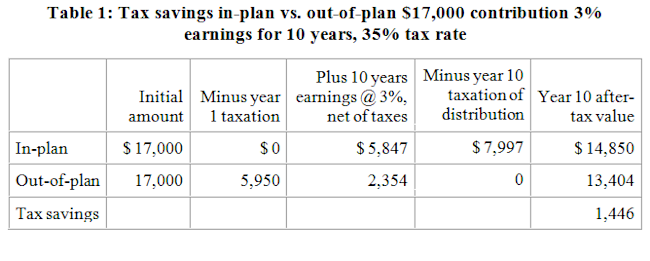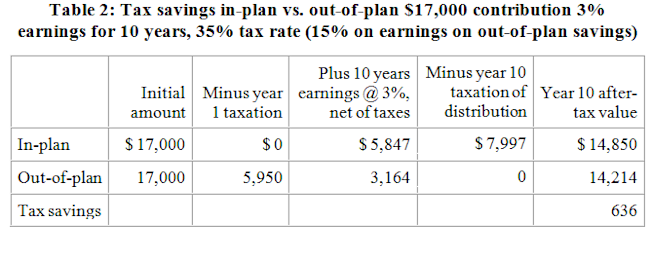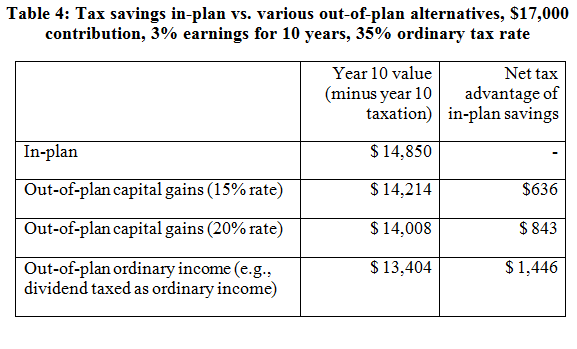Fiscal cliff & retirement plans: Capital gain & dividend taxes
Fiscal cliff & retirement plans: Capital gain & dividend taxes
We have posted a series of articles on the impact on 401(k) plan participants of possible changes in the Tax Code, including “The value of retirement benefits and tax policy”, “The ‘fiscal cliff’ and retirement plan participants”, “The fiscal cliff and retirement plans: ‘caps on deductions’”, and “The fiscal cliff and retirement plans: Medicare taxes”. Those articles generally treated ‘outside the plan’ savings as taxable at ordinary income tax rates.
In this article we consider, first, the relevance of different tax rates for capital gains and dividends under current law, and, second, the impact on participants of changes in those rates (e.g., in connection with changes that may emerge from ongoing budget negotiations.)
Current capital gains and dividend rates
In our prior articles, as we have compared saving through a tax qualified plan (generally, a 401(k) plan) with saving ‘outside the plan,’ we have treated income on ‘outside the plan’ savings as taxable at ordinary income rates (2012 top rate = 35%). Under the Tax Code, however, capital gains and dividends have historically been taxed at a lower rate – for the past several years, 15% — than ordinary income. How does that affect the relative ‘tax value’ of saving in a 401(k) plan vs., e.g., buying a growth stock or stock that pays out earnings in dividends?
Base case
Let’s begin with our base case — comparing the value of in-plan vs. out-of-plan savings where out-of-plan savings earnings are taxed as ordinary income.
As in the prior analyses of tax effects we have done, we’ll assume a participant contributes $17,000 to a 401(k) plan and leaves the money in the plan for 10 years and that in the plan these savings earn 3% per year. What is the value of that $17,000 after 10 years, net of taxes, vs. paying taxes immediately and saving outside the plan?
Table 1 shows the tax saving (after 10 years) the participant realizes if she saves in the plan rather than outside of it. (A full discussion of our methodology can be found in our prior articles in this series.)

Bottom line, with these assumptions, under current tax rules, the participant has $1,446 more in 10 years than she would have had if she had saved outside the plan. That’s where the participant is paying taxes on out-of-plan savings at the top ordinary income tax rate, currently 35%.
Impact of capital gains and dividend tax rates on the value of retirement savings
Now let’s consider the value of in-plan vs. out-of-plan savings where out-of-plan savings are invested in capital gains or dividends-producing investments. We will make one simplifying assumption — that all earnings the out-of-plan investment produces are taxed annually, so that, in effect, earnings on out-of-plan savings are taxed at a 15% rate. Table 2 shows the value of in-plan vs. out-of-plan savings in these circumstances.

Thus, a out-of-plan capital gains or dividends strategy significantly reduces the value of in-plan savings — by $810 or 56%. (The value of a out-of-plan ‘buy and hold’ capital gains strategy is slightly higher, $14,280, reducing the incremental value of in-plan savings by another $66.)
Impact of proposed changes to capital gains and dividend rates
Based on stopgap legislation enacted at the beginning of the year to avoid the ‘fiscal cliff’, capital gains and dividend tax rates will not rise for 2013 for most taxpayers. High-income taxpayers (those with incomes above $400,000) will see the capital gain and dividend tax rate increase from 15% to 20% this year. (Had no law been passed, the capital gains rate would have increased to 20% for all taxpayers, and dividends would be taxed at ordinary income tax rates.) Complicating the analysis, the top ordinary income tax rate is increasing to 39.6%; Medicare taxes will go up 0.9%; and a new Medicare tax, 3.8% on net investment income will generally apply to both capital gains and dividends for those with high incomes.
We will shortly publish an article pulling together all of the changes being considered that will take into account all of these possible new tax provisions. But in this article we are focusing only on capital gains and dividend treatment, so we will hold the income tax rate constant at 35% (and ignore Medicare taxes) and consider the impact on the value of in-plan vs. out-of-plan savings where the capital gains rate goes up to 20% and dividends are taxed as ordinary income.
Given those assumptions, a dividend strategy for out-of-plan investments will produce the same results as an ordinary income strategy — so the results will look like Table 1, above. Table 3 shows the value of in-plan vs. out-of-plan savings where out-of-plan savings are invested in capital gains producing investments taxed at a 20% rate.

The relative advantage of in-plan savings goes up by a little more than $200. At a 15% capital gains rate in-plan savings are worth $636 more than out-of-plan savings; at a 20% capital gains rate they are worth $843 more.
Table 4 summarizes the tax savings an in-plan investment strategy provides relative to a capital gains strategy at alternative out-of-plan rates.

* * *
The foregoing is intended to illustrate the significance of capital gains and dividend tax rates for an in-plan vs. out-of-plan analysis. The “true value” of the 401(k) plan tax benefit can only be finally determined when all the relevant variables are considered. In our next article we will summarize all the elements of the relevant tax equation — ordinary income, capital gains, dividend and Medicare taxes – and analyze 401(k) plan tax treatment under current rules, considering changes already taking effect in 2013 and additional changes under consideration in Washington.
